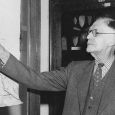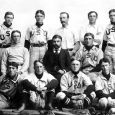The Gift of South Dakota
Subscriptions to South Dakota Magazine make great gifts!
Subscribe today — 1 year (6 issues) is just $29!
The King Hits the Road
Jul 2, 2015
One of the world’s greatest musical instruments, a 16th century Amati ‘King’ cello housed at the National Music Museum (NMM) in Vermillion, is part of a summer-long exhibition at The Metropolitan Museum of Art in New York.
“The ‘King’ is one of the National Music Museum’s crown jewels, the ‘Mona Lisa’ of Italian stringed instruments,” said NMM Director Cleveland Johnson. “We are proud to share this treasure with The Met and its many visitors this summer. We’re especially grateful to the NMM’s corporate sponsor, Citi, for underwriting the expenses of this loan and making the King’s trip to New York possible.”
The Amati ‘King’ cello is the earliest surviving bass instrument of the violin family. Made in the mid-1500s by Andrea Amati, the founding master of the Cremonese violin tradition, the ‘King’ remains an iconic masterwork of the Italian Renaissance. The innovative craftsmanship of Andrea Amati, his sons, and grandsons directly influenced Antonio Stradivari and an entire lineage of renowned stringed-instrument makers.
The ‘King’ derives its name from its royal commissioning. In the 1560s, the instrument was painted and gilded with the emblems and mottoes of King Charles IX of France, son of Catherine de’ Medici. The cello formed part of a set of 38 Amati stringed instruments made for the Valois court. Evidence suggests that this set was dispersed by the end of the French Revolution, according to NMM Curator of Stringed Instruments Arian Sheets, and only a few of the instruments have survived.
“Years later, around 1801, the ‘King’ was ‘modernized’ and cut down in size, possibly by Parisian maker Sébastian Renault,” said Sheets. “Wood was visibly removed down the center of the cello‘s back, leaving the painted and crowned woman who represents ‘Justice’ without her waist, left arm, and her scales of justice. Despite the alteration, the instrument retains its beauty and rich sound.”
Given its rarity and value, the ‘King’ travels infrequently. The last time was in 2007, when it returned to its birthplace in Cremona, Italy, to headline the Andrea Amati Opera Omnia exhibition.
For the cello’s trip to the Met, only royal arrangements would do. It was swathed in protective cases to insure a proper, stable environment and trucked to New York in one climate-controlled 24-hour run.
“We are delighted to host the King cello this summer,” said Ken Moore, Frederick P. Rose Curator in charge of the Department of Musical Instruments at the Metropolitan Museum. “This collaboration with The National Music Museum provides an opportunity for thousands of our visitors to see and study this rare and important masterwork alongside other instruments by Andrea Amati, his family and other great Cremonese makers like Antonio Stradivari.”
While in New York, the ‘King’ will be an ambassador for The National Music Museum said Director Johnson. “We work unceasingly at the NMM to introduce new audiences to our nation’s preeminent collection of musical instruments and archives. We are supported at present almost completely by local and state resources, so we need music-lovers across America to support our mission too — especially with a much-needed new museum facility in the works."











Comments